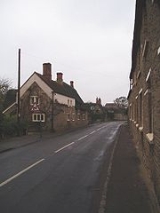
Pavenham
Encyclopedia
Pavenham is a small village and civil parish on the River Great Ouse
in the Bedford district of Bedfordshire
, England
, about 6 miles (10 km) north-west of Bedford
. Village amenities consist of a pub
, Village hall, tennis Club, and golf club. The village is home to many clubs and societies including an active WI.
Time Line
1205:Church first mentioned as a chapel or daughter church to Felmersham
13th Century: Church exists only as a nave and chancel
14th Century:The tower, spire and the chapel north of the chancel added to the Church
15th Century: North aisle and south transept (a chapel) added to the Church
1578: Churchwardens report Trinity College for letting the Church fall into disrepair
1665: The year that the Pavenham Old Yew Tree believed to have been planted, the year of the Great Plague
1770:Pavenham Enclosure Act
1798:Workhouse first mentioned
1813: Water Mill closed
1827:Sunday School Started
1853: Church of England School opened, provided by Squire Tucker
1857: Wesleyan Chapel built
1877: Vicarage built, designed by Bedford architect John Usher
1888: Cricket Club Founded
1920: War memorial unveiled
1935: Electricity came to the village
1938: The Cock Inn substantially rebuilt
1955: Roof to the nave of the Church replaced
1959: Village Hall re-opened after improvements made
1960: Pavenham Bury demolished
1961: The Old Yew Tree transplanted 15 feet from its original position as part of a road improvement scheme
1965: Pavenham Women's Institute plant oak in the playing fields to commemorate the Golden Jubilee of the Women's Institute
1967: Pavenham Sports Pavilion Opened - built by local builder Charles Cartlidge.
1972: Vicarage demolished
1980: New Village Hall opened
1983: Village school closed
2010: Bedfordseasider moved in
River Great Ouse
The Great Ouse is a river in the east of England. At long, it is the fourth-longest river in the United Kingdom. The river has been important for navigation, and for draining the low-lying region through which it flows. Its course has been modified several times, with the first recorded being in...
in the Bedford district of Bedfordshire
Bedfordshire
Bedfordshire is a ceremonial county of historic origin in England that forms part of the East of England region.It borders Cambridgeshire to the north-east, Northamptonshire to the north, Buckinghamshire to the west and Hertfordshire to the south-east....
, England
England
England is a country that is part of the United Kingdom. It shares land borders with Scotland to the north and Wales to the west; the Irish Sea is to the north west, the Celtic Sea to the south west, with the North Sea to the east and the English Channel to the south separating it from continental...
, about 6 miles (10 km) north-west of Bedford
Bedford
Bedford is the county town of Bedfordshire, in the East of England. It is a large town and the administrative centre for the wider Borough of Bedford. According to the former Bedfordshire County Council's estimates, the town had a population of 79,190 in mid 2005, with 19,720 in the adjacent town...
. Village amenities consist of a pub
Public house
A public house, informally known as a pub, is a drinking establishment fundamental to the culture of Britain, Ireland, Australia and New Zealand. There are approximately 53,500 public houses in the United Kingdom. This number has been declining every year, so that nearly half of the smaller...
, Village hall, tennis Club, and golf club. The village is home to many clubs and societies including an active WI.
Time Line
1205:Church first mentioned as a chapel or daughter church to Felmersham
13th Century: Church exists only as a nave and chancel
14th Century:The tower, spire and the chapel north of the chancel added to the Church
15th Century: North aisle and south transept (a chapel) added to the Church
1578: Churchwardens report Trinity College for letting the Church fall into disrepair
1665: The year that the Pavenham Old Yew Tree believed to have been planted, the year of the Great Plague
1770:Pavenham Enclosure Act
1798:Workhouse first mentioned
1813: Water Mill closed
1827:Sunday School Started
1853: Church of England School opened, provided by Squire Tucker
1857: Wesleyan Chapel built
1877: Vicarage built, designed by Bedford architect John Usher
1888: Cricket Club Founded
1920: War memorial unveiled
1935: Electricity came to the village
1938: The Cock Inn substantially rebuilt
1955: Roof to the nave of the Church replaced
1959: Village Hall re-opened after improvements made
1960: Pavenham Bury demolished
1961: The Old Yew Tree transplanted 15 feet from its original position as part of a road improvement scheme
1965: Pavenham Women's Institute plant oak in the playing fields to commemorate the Golden Jubilee of the Women's Institute
1967: Pavenham Sports Pavilion Opened - built by local builder Charles Cartlidge.
1972: Vicarage demolished
1980: New Village Hall opened
1983: Village school closed
2010: Bedfordseasider moved in

